Most commented posts
- Phonons: shake those atoms — 3 comments
- Start to Fortran — 1 comment

Jul 18 2022
| Authors: | Danny E.P. Vanpoucke, Marie A.F. Delgove, Jules Stouten, Jurrie Noordijk, Nils De Vos, Kamiel Matthysen, Geert G.P. Deroover, Siamak Mehrkanoon, and Katrien V. Bernaerts |
| Journal: | Polymer International 71(8), i-i (2022) |
| doi: | 10.1002/pi.6434 |
| IF(2015): | 3.213 |
| export: | bibtex |
| pdf: | <PolymerInt> |
The cover image is based on the Research Article A machine learning approach for the design of hyperbranched polymeric dispersing agents based on aliphatic polyesters for radiation-curable inks by Danny E.P. Vanpoucke et al., https://doi.org/10.1002/pi.6378. (The related paper can be found here.)
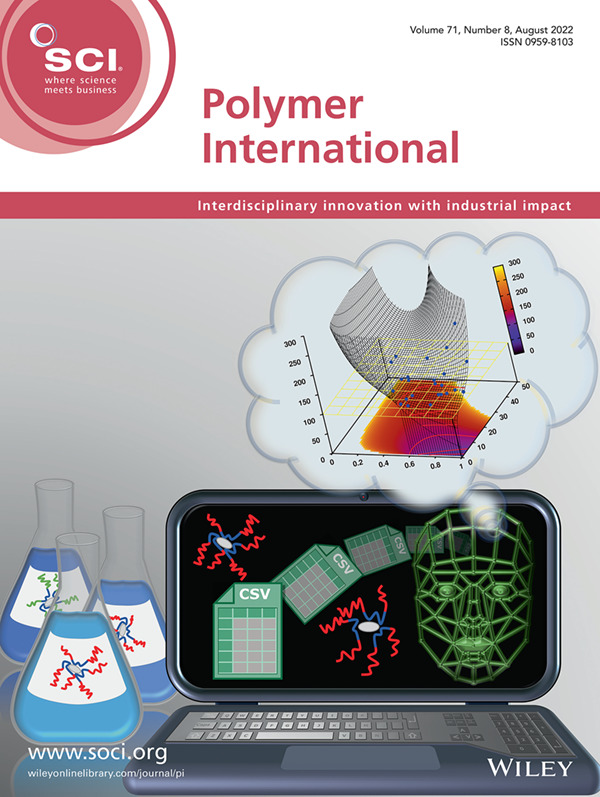
Cover Polymer International: Machine learning on small data sets, application on UV curable inks.
Jul 16 2022
| Authors: | Danny E.P. Vanpoucke, Marie A.F. Delgove, Jules Stouten, Jurrie Noordijk, Nils De Vos, Kamiel Matthysen, Geert G.P. Deroover, Siamak Mehrkanoon, and Katrien V. Bernaerts |
| Journal: | Polymer International 71(8), 966-975 (2022) |
| doi: | 10.1002/pi.6378 |
| IF(2021): | 3.213 |
| export: | bibtex |
| pdf: | <PI> (Open Access) (Cover Paper) |
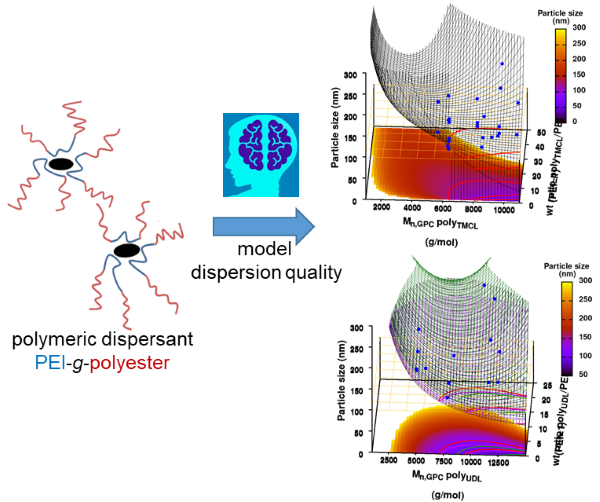 |
| Graphical Abstract:An ensemble based machine learning model for small datasets was used to predict the relationship between the dispersant structure and the pigment dispersion quality (particle size) for radiation curable formulations. |
Polymeric dispersing agents were prepared from aliphatic polyesters consisting of δ-undecalactone (UDL) and β,δ-trimethyl-ε-caprolactones (TMCL) as biobased monomers, which are polymerized in bulk via organocatalysts. Graft copolymers were obtained by coupling of the polyesters to poly(ethylene imine) (PEI) in the bulk without using solvents. Different parameters that influence the performance of the dispersing agents in pigment based UV-curable matrices were investigated: chemistry of the polyester (UDL or TMCL), weight ratio of polyester/PEI, molecular weight of the polyesters and of PEI. The performance of the dispersing agents was modelled using machine learning in order to increase the efficiency of the dispersant design. The resulting models were presented as analytical models for the individual polyesters and the synthesis conditions for optimal performing dispersing agents were indicated as a preference for high molecular weight polyesters and a polyester dependent maximum weight ratio polyester/PEI.
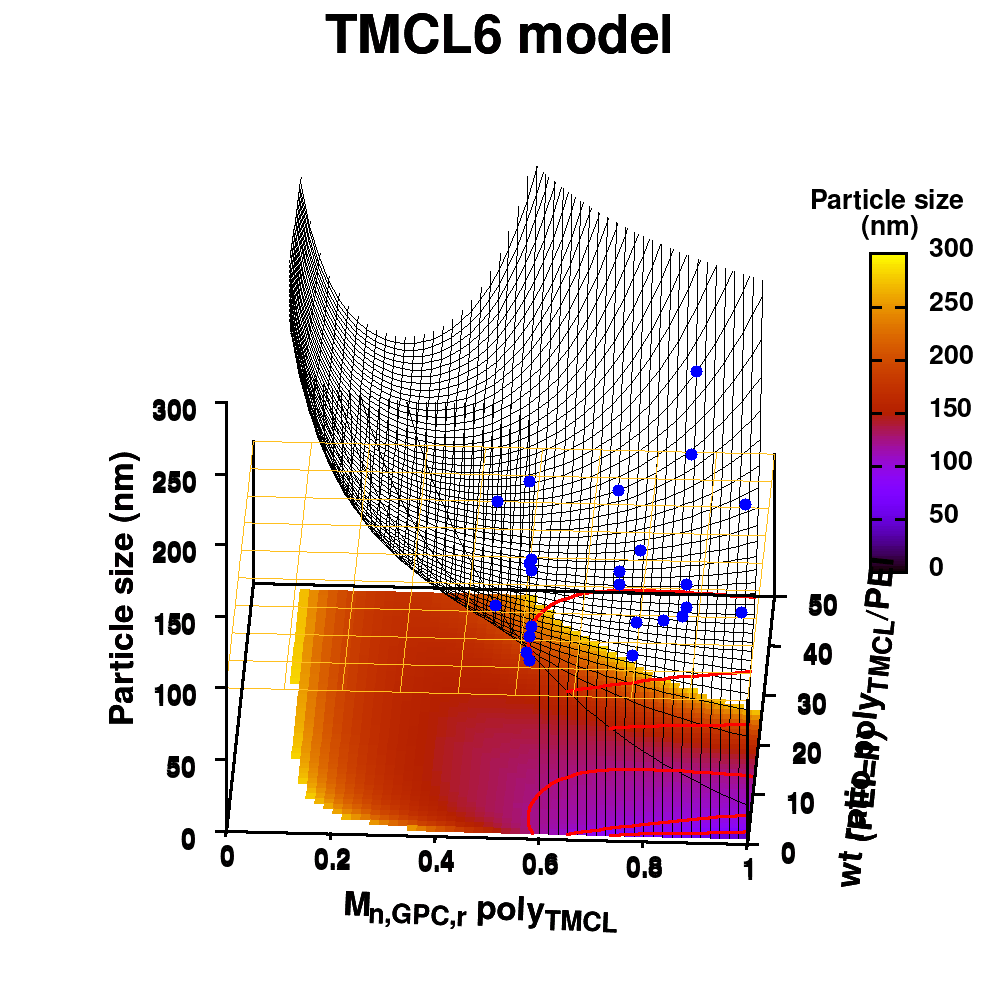
Animation of TMCL model 6
Mar 10 2022
| Authors: | Sergey Mitryukovskiy, Danny E. P. Vanpoucke, Yue Bai, Théo Hannotte, Mélanie Lavancier, Djamila Hourlier, Goedele Roos and Romain Peretti |
| Journal: | Physical Chemistry Chemical Physics 24, 6107-6125 (2022) |
| doi: | 10.1039/D1CP03261E |
| IF(2020): | 3.676 |
| export: | bibtex |
| pdf: | <PCCP> |
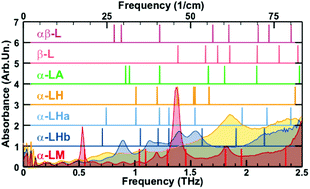 |
| Graphical Abstract: Comparison of the measured THz spectrum of 3 phases of Lactose-Monohydrate to the calculated spectra for several Lactose configurations with varying water content. |
The nanoscale structure of molecular assemblies plays a major role in many (µ)-biological mechanisms. Molecular crystals are one of the most simple of these assemblies and are widely used in a variety of applications from pharmaceuticals and agrochemicals, to nutraceuticals and cosmetics. The collective vibrations in such molecular crystals can be probed using terahertz spectroscopy, providing unique characteristic spectral fingerprints. However, the association of the spectral features to the crystal conformation, crystal phase and its environment is a difficult task. We present a combined computational-experimental study on the incorporation of water in lactose molecular crystals, and show how simulations can be used to associate spectral features in the THz region to crystal conformations and phases. Using periodic DFT simulations of lactose molecular crystals, the role of water in the observed lactose THz spectrum is clarified, presenting both direct and indirect contributions. A specific experimental setup is built to allow the controlled heating and corresponding dehydration of the sample, providing the monitoring of the crystal phase transformation dynamics. Besides the observation that lactose phases and phase transformation appear to be more complex than previously thought – including several crystal forms in a single phase and a non-negligible water content in the so-called anhydrous phase – we draw two main conclusions from this study. Firstly, THz modes are spread over more than one molecule and require periodic computation rather than a gas-phase one. Secondly, hydration water does not only play a perturbative role but also participates in the facilitation of the THz vibrations.
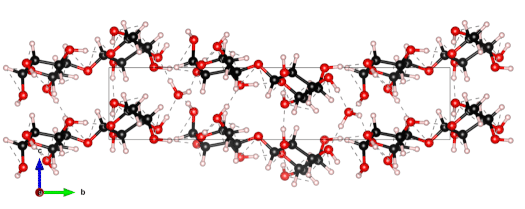
The 0.5 THz finger-print mode of alpha-lactose monohydrate.
Feb 27 2022
Python, as any other scripting language allows you to define variables and functions. These are very basic entities when it comes to programming. However, sometimes it is useful to keep variables and functions that are related to one-another close together. This is the main idea behind Object Oriented programming and is present in programming languages such as C++ and fortran, but also in scripting languages like java and python. In this tutorial, you can find a first brief introduction into this topic, focusing on the concept of a class.
This tutorial is part of a series of tutorials and the code is available via GitHub. As a real life example, used throughout this series, we consider a class for solving a wordle-puzzle.
A class is a complex variable type, which contains specific methods (or functions) and attributes (or properties). An instance of such a complex variable is called an object, and different objects can have different values for their attributes (and even methods).
To create a class in python the class keyword is used followed by the name you want to assign your class. In our case this is the WordleAssistant class.
class WordleAssistant():
This WordleAssistant contains the attributes relevant to our puzzle solver. For example, if we want to make a generic solver, two useful attributes would be the wordle word length (WordleSize) and a dictionary of possible words (FullWordset). Unlike fortran or C++, attributes are not defined in the class definition, but can be dynamically created for a class-object. This a feature (or design flaw) gives rise to some dangerous practices such as the runtime (accidental) addition of attributes to an object. For good practices, one should refrain from this and create all attributes by initializing them during the initialization of the class instance. This is done using the __init__() method of the class:
class WordleAssistant(): def __init__(self, size: int = 5, dictionary: str = None): self.WordleSize = size if dictionary is None: dictionary = "Mydict.txt" self.FullWordset = self.readDictionary(dictionary)
Here the WordleSize attribute is defined by setting it to the size parameter of the __init__ method, while the FullWordset attribute is defined by assigning it the result of the readDictionary method of the WordleAssistant class. As is common (and good) practice in OO langues we use the self variable to indicate the instance of the class, binding attributes and methods to the instance. You may also have noted python uses a dot-notation to indicate attributes/methods of a class, similar as C++ (while fortran uses the % symbol with the same effect).
!! NOTE: There also exist “class attributes” which are defined the way one would define instance attributes in fortran or C++. However, in python these attributes are shared by all instances of the class, as such changing them in one object will change them in all objects, creating a mess.
In the previous section, we already defined a first method, the initialization method. As a method is a function, it is constructed as any other function in python using the def keyword, with the body indented. The method itself is indented one level with respect to the class level. Similar as for a usual function, one can indicate the expected type and default value for each function parameter, and if a result is returned the type can be indicated as well, as can be seen in the example below for the readDictionary method.
class WordleAssistant(): def __init__(self, size: int = 5, dictionary: str = None): ... def readDictionary(self, wordlist: str = None)->list: ... return wordlist
Although private attributes and methods don’t technically exist in Python, it is convention that attributes and methods prefixed with a single underscore are to be treated as non-public parts of the API. In addition, using two or more underscores gives rise to name mangling, which gives a practical behavior akin to making attributes and methods private. The __init__ method above is an example. We will come back to this when discussing inheritance and child classes.
Once the class is implemented, it can be used in a script by creating instances of the class. These instances are called Objects.
WA = WordleAssistant()
The above command creates an object WA which is of the class WordleAssistant. The object is initialized through a call to the __init__ method, which is performed by the assignment above. If defaults are provided for all parameters of the __init__ method, then no variables need to be passed to the WordleAssistant class call. Otherwise the creation of an instance could look like this:
wordleSize = 5 WA = WordleAssistant(size=wordleSize,dictionary='MyWords.txt')
Access to the attributes and methods of the WA object s gained using the dot-notation:
wordsize = WA.WordleSize wordlist = WA.FullWordset Top10Guess = WA.getTop(top = 10)
Within the context of data-encapsulation one should never access attributes directly but use get and set methods instead.
Feb 16 2022
Over that last few months the wordle game has become increasingly popular, with people sharing their daily feats on Twitter. Currently the game is hosted by the NY times which bought it the end of January 2022 from its creator. The game is rather straightforward: you have 6 guesses to find a 5-letter English word. Every guess, the game tells you if a letter is (1) not in the word [grey], (2) in the word at a different position [yellow/orange], or (3) in the word at the exact same position [green].
| Wordle 242 4/6 ⬛⬛🟨⬛⬛ ⬛🟨⬛⬛⬛ ⬛⬛🟩🟨🟩 🟩🟩🟩🟩🟩 |
An example of the result (as it looks when shared on Twitter). My first guess was the word “PIANO”, which means the A is in the word but at a different position. My second word, “QUERY”, adds the U to the list of letters that are present. With my third guess, “STUCK”, the position of the U and the K are fixed and we now also know the letter C is involved. At this point, I was also stuck, so I got some help of my wordle-assistant program, which taught me there could only be 1 word matching all the information we had: “CAULK“. |
This seamlessly brings me to the central topic of this post: writing a program to help win this game as efficiently as possible. Not terribly original, but it’s a means to an end, as this simple project allows us to explore some more advanced topics in programming in python as well as artificial intelligence.
During this exploration I’ll be including and updating a set of tutorials as well as this post. The python side of the project will focus on efficiency and easy of use and distribution, while the AI side will focus on smart ways predicting the best possible next guess. For the latter, an important caveat is that this means that the program should also work if you’re the last player living on earth, or if you decide to play wordle in a different language or a different number of letters. This means that creating a distribution of the tweeted results of other players and comparing this with the complete set of brute-forced distributions to guess the wordle of the day in a single guess, would not satisfy my definition of AI. It is an interesting Big-data kaggle competition though.
All tutorial code and jupyter notebooks can be found in this github repository.
Jan 21 2022
| Authors: | Dries De Sloovere, Danny E. P. Vanpoucke, Andreas Paulus, Bjorn Joos, Lavinia Calvi, Thomas Vranken, Gunter Reekmans, Peter Adriaensens, Nicolas Eshraghi, Abdelfattah Mahmoud, Frédéric Boschini, Mohammadhosein Safari, Marlies K. Van Bael, An Hardy |
| Journal: | Advanced Energy and Sustainability Research 3(3), 2100159 (2022) |
| doi: | 10.1002/aesr.202100159 |
| IF(2022): | ?? |
| export: | bibtex |
| pdf: | <AdvEnSusRes> (OA) |
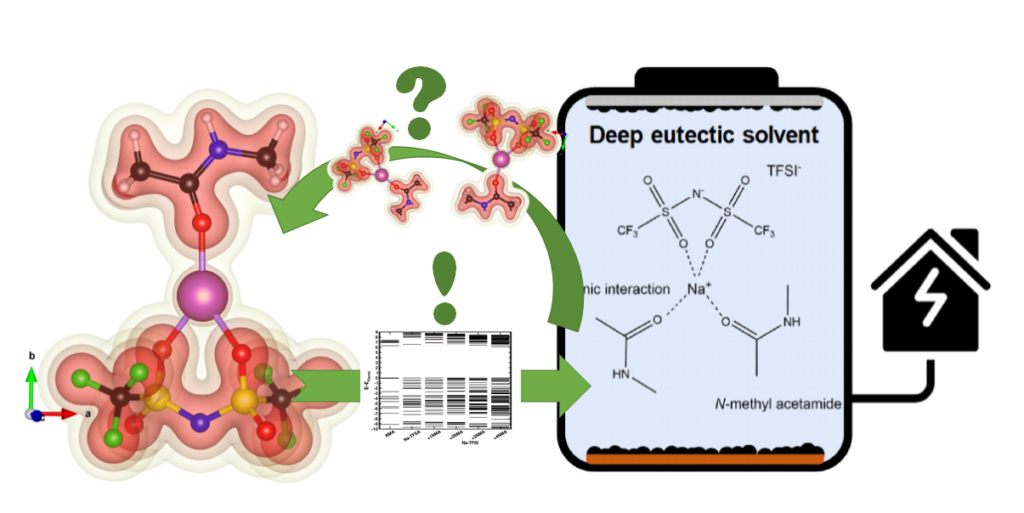 |
| Graphical Abstract: Understanding the electronic structure of Na-TFSI interacting with NMA. |
Sodium-ion batteries are alternatives for lithium-ion batteries in applications where cost-effectiveness is of primary concern, such as stationary energy storage. The stability of sodium-ion batteries is limited by the current generation of electrolytes, particularly at higher temperatures. Therefore, the search for an electrolyte which is stable at these temperatures is of utmost importance. Here, we introduce such an electrolyte using non-flammable deep eutectic solvents, consisting of sodium bis(trifluoromethane)sulfonimide (NaTFSI) dissolved in N-methyl acetamide (NMA). Increasing the NaTFSI concentration replaces NMA-NMA hydrogen bonds with strong ionic interactions between NMA, Na+, and TFSI–. These interactions lower NMA’s HOMO energy level compared to that of TFSI–, leading to an increased anodic stability (up to ~4.65 V vs Na+/Na). (Na3V2(PO4)2F3/CNT)/(Na2+xTi4O9/C) full cells show 74.8% capacity retention after 1000 cycles at 1 C and 55 °C, and 97.0% capacity retention after 250 cycles at 0.2 C and 55 °C. This is considerably higher than for (Na3V2(PO4)2F3/CNT)/(Na2+xTi4O9/C) full cells containing a conventional electrolyte. According to the electrochemical impedance analysis, the improved electrochemical stability is linked to the formation of more robust surface films at the electrode/electrolyte interface. The improved durability and safety highlight that deep eutectic solvents can be viable electrolyte alternatives for sodium-ion batteries.
Dec 31 2021
| Authors: | Danny E. P. Vanpoucke and Sylvia Wenmackers |
| Journal: | Chaos 31, 123131 (2021) |
| doi: | 10.1063/5.0063388 |
| IF(2021): | 3.642 |
| export: | bibtex |
| pdf: | <Chaos> (Open Access) <ArXiv v1> |
| github: | <NortonDomeExplorer> |
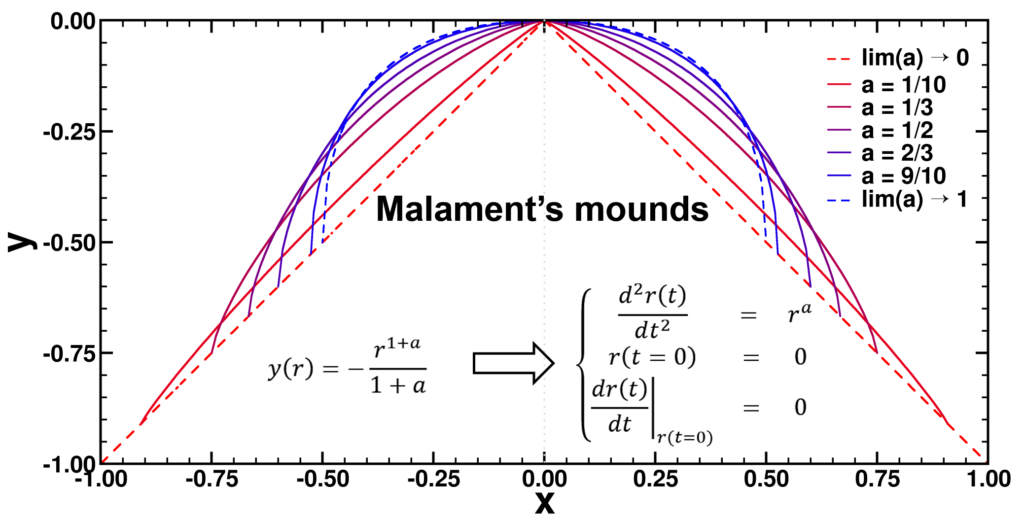 |
| Graphical Abstract: Examples of Malament’s Mounds, of which the Norton Dome is the special case where α=½. |
We present a method for assigning probabilities to the solutions of initial value problems that have a Lipschitz singularity. To illustrate the method, we focus on the following toy-example: ,
, and
, with a∈]0; 1[. This example has a physical interpretation as a mass in a uniform gravitational field on a dome of particular shape; the case with a = ½ is known as Norton’s dome. Our approach is based on (1) finite difference equations, which are deterministic; (2) elementary techniques from alpha-theory, a simplified framework for non-standard analysis that allows us to study infinitesimal perturbations; and (3) a uniform prior on the canonical phase space. Our deterministic, hyperfinite grid model allows us to assign probabilities to the solutions of the This allows us to assign probabilities to the solutions of the initial value problem in the original, indeterministic model.

Phase space vector field for all Malament’s mounds
May 06 2021
Happy to announce my TEDxUHasselt talk is officially part of the TEDx universe: https://www.ted.com/talks/danny_vanpoucke_the_virtual_lab .
I enjoyed talking about the VirtualLab. Showed examples from atoms to galaxies, from computer-chips to drug-design and from to opinion-dynamics to epidemiology. I looked at the past and and glanced towards the future, where machine learning and artificial intelligence are the new kids on the block.
Apr 04 2021
Recently, I decided to add a custom registration form to my website, as part of an effort to improve and streamline the “HIVE-STM tool experience” 😉 . Up until now, potential users had to directly send me an e-mail, telling me a bit more about themselves and their work. I would then e-mail them the program, and add their information to a user list for future reference (i.e., support and some statistics for my personal entertainment).
This has the drawback that any future user needs to wait until I find the time to reply. To improve on the user-friendliness, I thought it would be nice to automate this a bit. A first step in this process entails making the application a bit more uniform: using an online registration form.
 What started out with the intention of being an almost trivial exercise in building a web-form, turned into a steep learning curve about web-development and cyber-security. I am aware there exists many tools which generate forms for websites or even provide you a platform which hosts the form (e.g., google-forms, which I used in the past), but I wanted to do implement it myself (…something to do with pride 😉 ). Having build websites using HTML and CSS in the past, and having some basic experience with Javascript, this looked like a fun afternoon project. The HTML for the form was easily created using the tutorials found on w3schools.com and an old second edition “Handboek HTML5 en CSS3“, I picked up a few years ago browsing a second hand bookshop. Trouble, however, started rearing its ugly head as soon as I wanted to integrate this form in this WordPress website. Just pasting this into a page or post doesn’t really work, as WordPress wants to “help” you, and prevent you from hurting yourself. This is a fantastic feature if you have no clue about HTML/CSS/… or don’t want to care about it. Unfortunately, if you want to do something slightly more advanced you are in for a hell of a ride, as you find out the relevant bits get redacted or disabled.
What started out with the intention of being an almost trivial exercise in building a web-form, turned into a steep learning curve about web-development and cyber-security. I am aware there exists many tools which generate forms for websites or even provide you a platform which hosts the form (e.g., google-forms, which I used in the past), but I wanted to do implement it myself (…something to do with pride 😉 ). Having build websites using HTML and CSS in the past, and having some basic experience with Javascript, this looked like a fun afternoon project. The HTML for the form was easily created using the tutorials found on w3schools.com and an old second edition “Handboek HTML5 en CSS3“, I picked up a few years ago browsing a second hand bookshop. Trouble, however, started rearing its ugly head as soon as I wanted to integrate this form in this WordPress website. Just pasting this into a page or post doesn’t really work, as WordPress wants to “help” you, and prevent you from hurting yourself. This is a fantastic feature if you have no clue about HTML/CSS/… or don’t want to care about it. Unfortunately, if you want to do something slightly more advanced you are in for a hell of a ride, as you find out the relevant bits get redacted or disabled.
Searching for specific solutions with regard to creating a custom form in WordPress I was astounded at how often the default suggestion is: “use plugin XXX” or “use tool YYY”. Are we loosing the ability to want to craft something ourselves? Yes of course, there are professional tools available which can be better than anything you yourself can build in a short amount of time…but should it discourage you of trying, and feeling the satisfaction of having created something? I digress.
In the end, I discovered a good quality tutorial (once you get past the reasons why not to do it) and I started a long uphill battle trying to bend WordPress to my will:
At this point, the form accepted input, and collected it via the PHP $_POST global variable. En route to this point, I read quite a few warnings about Cross-Site Request Forgery (CSRF) and that one should protect against it. Luckily, the tutorial practically showed how to do this in WordPress using nonces…in contrast to WordPress theme handbook which gives in formation, but not easy to understand if you are new to the subject.
With a basic sense of security, I was aiming at making things user-friendly, i.e., if something goes wrong it would be nice if you do not need to again fill out the form entirely. Searching for ways to keep this information I came across a lot of options, none of which seemed to work (cookies, PHP variables, global variables, etc). The problem appeared to originate from the fact that the information was not persistent. Once the web page started reloading, everything got erased. It was only at this point that I learned about “transients” in WordPress, and using get_transient() and set_transient() resolved all the issues instantaneously. There is only one caveat at this point: If two potential users submit their registration at almost the same time one may end up seeing the registration information of the other. (However, at this time the program is far from famous enough to present any issues, so statistics will save us from this).
Only one thing remained to be done: put all relevant information into two e-mail messages, one to be sent to myself, and one to be sent to the potential user. For this, I made use of the PHP mail() function. It works quite nicely, and after playing around with it for a bit (and convincing myself a nice HTML formatted layout will not work for example in gmail) the setup was complete. That evening, I went to bed, happy with the accomplishment: I had created something.
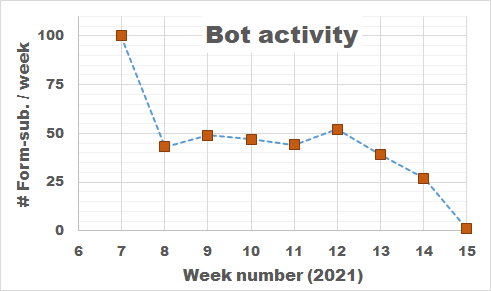
Bot Activity on the HIVE registration form during February and March of 2021.
The next morning, I was amazed to find already several applications for the HIVE-STM program in my mailbox (that is, in addition to my own test runs). These were not sent by real humans, but appeared to be the work of bots just filling out the form and sending it off. This left me a bit puzzled, and I have been looking for the reason why anyone would actually bother writing a bot for this purpose. So far I’ve seen the suggestion that this is to improve the SEO of websites, generate spam-email (to yourself or with you as middleman), DOS-attacks, get access to your SQL database via code injection,…and after all my searches, I start to get the impression this may also be a means of promoting all the plugins, tools, frameworks that block these bots? In roughly each discussion you find, there will be at least one person promoting such a foolproof perfect tool 😯 🙄 …but might just be me.
So how do we deal with these bots, preferably without driving potential users crazy? Reading all the suggestions (which unfortunately provide extremely little information on the actual working and logic of spam-bots themselves) I added, in several rounds, some tricks to block/catch the bots, and have been tracking the submits since the form went live. As you can see there is a steady stream of some 50 bots weekly trying to fill out the form. The higher number in the first week is due to any submission being redirected to the original form page, as such the same bots performed multiple attempts within the time-range of a few minutes. In about two months, I collected the results of 400 registration attempts by bots (and 4 by humans).
Analyzing the results, I learned learned some interesting things.
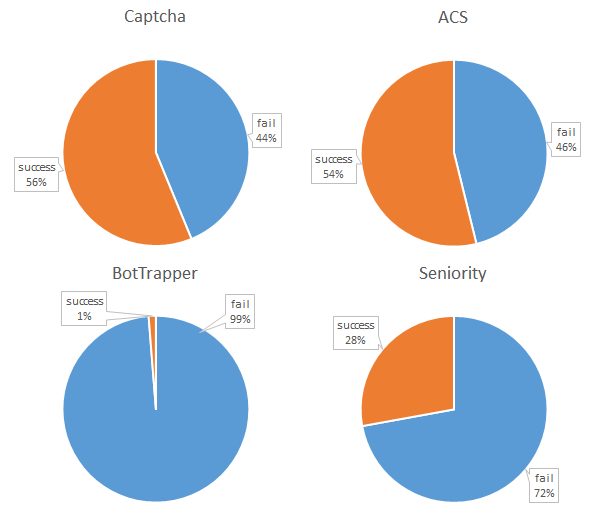
How to catch a bot? I track 4 different signals which may be indicative of bot behavior.
One of the first things to add, from a human perspective is “a captcha”. The captcha is manually implemented simple random sum/product/subtraction. It should be easy for humans, but it is annoying as they need to fill out an extra field (and may fill it out incorrectly). Interestingly, 56% of the bots fill out the Captcha correctly. Of course more complicated versions could be implemented or used…but the bottom line is simple: it generally does not do the job, and annoys the actual human being.
Going beyond captcha’s, a lot of tutorials suggest the use of a honeypot. One can either make use of automated options of existing frameworks, plugins or …implement these oneself. This option appears to be very successful in targeting bots. The 1% successful cases coincided with the only human submissions. At this point we appear to have a “fool-proof” method for distinguishing between humans and bots.
Interestingly, drop-down menu’s with not generally used topics seem to throw off bots as well. The seniority drop-down menu shows failure rates even better than the captcha.
Writing your own form from scratch is a very interesting exercise, and well worth the time if you want to learn more about web-security as well as the inner workings of the framework used for your website. Bots are an interesting nuisance, and captcha’s just bother your user as most bots can easily deal with them. Logging the inputs of the bots does show a wide range in quality of these bots. Some just fill out garbage, while others appear to be quite smart, filling out reasonable answers. Other bots clearly have malignant purposes, which becomes clear from the code they try to plug into the form fields.
For now, the registration form seems to be able to distinguish between human-and bot-users. As such, we have successfully completed another step in upgrading the STM-program.